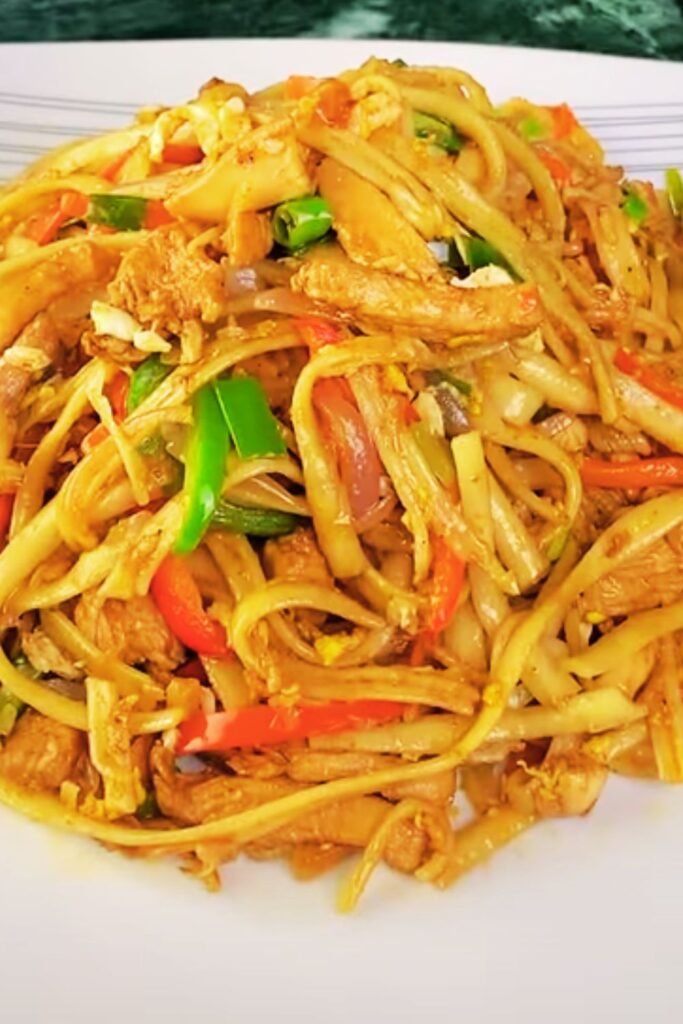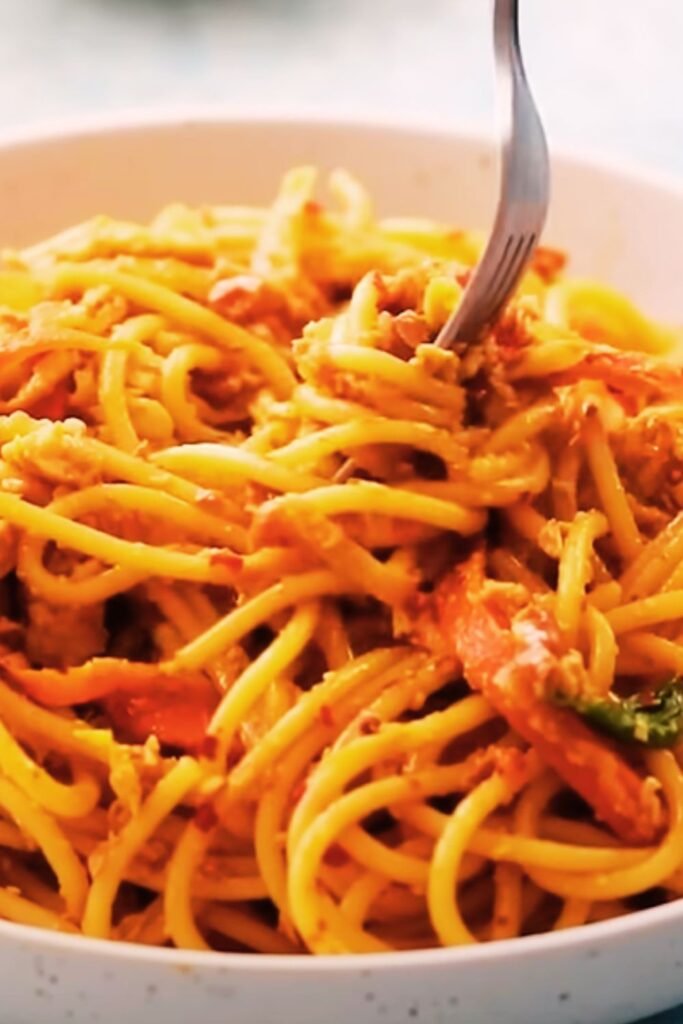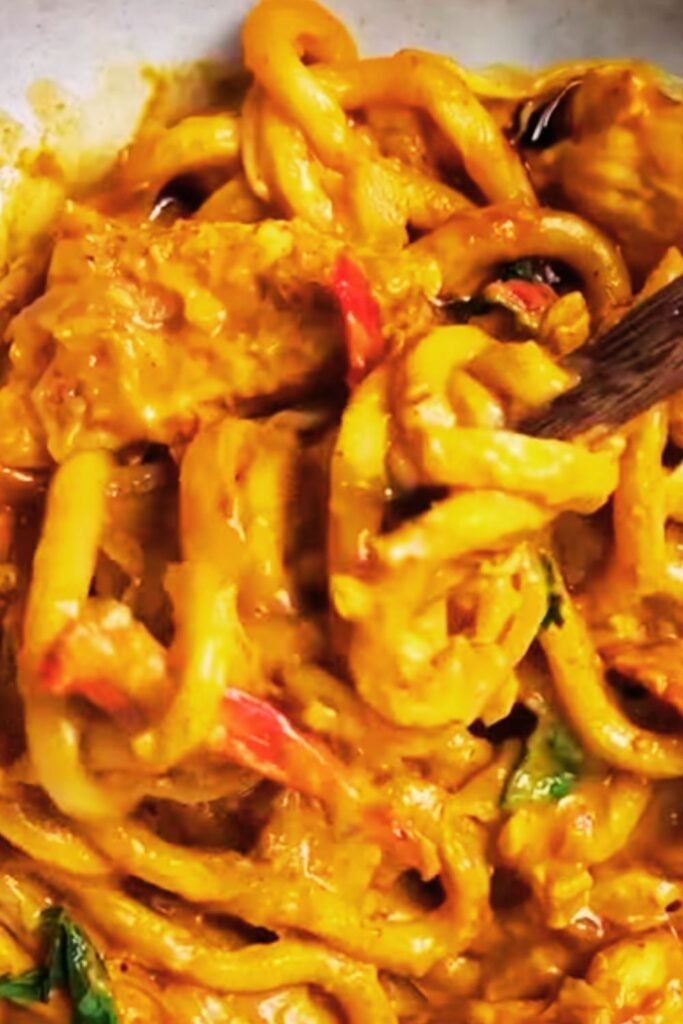I’ve been making Thai noodles for over a decade, and I can confidently say that this 20-minute spicy Thai noodle recipe has become my absolute go-to when I’m craving something bold, flavorful, and satisfying without spending hours in the kitchen. There’s something magical about the way Thai cuisine balances sweet, sour, salty, and spicy flavors that creates an explosion of taste in every single bite.
When I first started experimenting with Thai cooking, I was intimidated by the long ingredient lists and complex flavor profiles. But over the years, I’ve discovered that authentic Thai flavors can be achieved quickly and easily with the right techniques and ingredients. This recipe represents everything I love about Thai cuisine – it’s vibrant, aromatic, and incredibly satisfying.
The beauty of this dish lies not just in its speed, but in its versatility. I’ve served it as a quick weeknight dinner for my family, as a impressive dish for dinner parties, and even as a late-night comfort food when I’m craving something with a kick. The combination of rice noodles, fresh vegetables, and a perfectly balanced sauce creates a harmony that never fails to impress.
Understanding Thai Noodle Fundamentals
Before diving into the recipe, I want to share some key insights I’ve gained about Thai noodle dishes. The foundation of any great Thai noodle dish starts with understanding the balance of flavors that make Thai cuisine so distinctive.
Thai Flavor Profile : The perfect Thai dish achieves a balance of sweet, sour, salty, and spicy elements. In my spicy Thai noodles, I achieve this through palm sugar (sweet), lime juice and tamarind (sour), fish sauce (salty), and Thai chilies (spicy).
Noodle Selection : I prefer using fresh rice noodles when available, but dried rice stick noodles work perfectly well. The key is not to overcook them – they should have a slight chew while remaining tender.
Wok Hei Technique : This Cantonese term refers to the “breath of the wok” – the smoky flavor that comes from cooking over high heat. While not traditionally Thai, this technique elevates the dish significantly.
Mise en Place : French for “everything in its place,” this concept is crucial for Thai cooking. Since everything cooks quickly, having all ingredients prepped and ready is essential.
Essential Ingredients Breakdown
I’ve spent years perfecting the ingredient list for this recipe, and each component plays a crucial role in the final flavor profile. Here’s what makes this dish exceptional:
| Ingredient Category | Specific Items | Purpose | Substitution Options |
|---|---|---|---|
| Noodles | Fresh rice noodles (1 lb) | Base of the dish | Dried rice stick noodles, pad thai noodles |
| Proteins | Chicken thigh (8 oz), shrimp (6 oz) | Main protein source | Tofu, beef, pork, or just vegetables |
| Vegetables | Bean sprouts, bok choy, carrots, bell peppers | Texture and nutrition | Broccoli, snap peas, cabbage |
| Aromatics | Garlic (4 cloves), ginger (2 inches), shallots (2) | Flavor foundation | Onions, scallions |
| Sauce Base | Fish sauce, soy sauce, oyster sauce | Umami depth | Vegetarian alternatives available |
| Heat Elements | Thai bird’s eye chilies, chili oil | Spice level | Jalapeños, red pepper flakes |
| Finishing Touches | Lime juice, palm sugar, fresh herbs | Balance and brightness | Regular sugar, cilantro, Thai basil |
The protein combination I use creates incredible depth – chicken thighs stay moist during high-heat cooking while shrimp adds a sweet, oceanic flavor that complements the spicy elements beautifully.

My Signature Sauce Recipe
The sauce is absolutely the heart of this dish. I’ve refined this combination over countless iterations, and it delivers the perfect balance of flavors that make Thai cuisine so addictive.
Primary Sauce Components:
- 3 tablespoons fish sauce
- 2 tablespoons dark soy sauce
- 1 tablespoon light soy sauce
- 2 tablespoons oyster sauce
- 1 tablespoon palm sugar (or brown sugar)
- 2 tablespoons fresh lime juice
- 1 tablespoon tamarind paste
- 1 teaspoon chili oil with sediment
Aromatics Paste:
- 4 cloves garlic, minced
- 2 inches fresh ginger, grated
- 2 shallots, finely chopped
- 3-4 Thai bird’s eye chilies, minced
I always mix the sauce components in a small bowl before I start cooking. This ensures even distribution and prevents any single flavor from overpowering the others. The tamarind paste adds a subtle sourness that’s essential to authentic Thai flavor, while the palm sugar provides a complex sweetness that regular sugar simply can’t match.
Step-by-Step Cooking Process
My approach to this recipe focuses on efficiency without sacrificing flavor. Here’s exactly how I prepare this dish every single time:
Preparation Phase (5 minutes):
- Soak dried noodles in warm water if using dried varieties
- Slice chicken thighs into bite-sized pieces
- Clean and devein shrimp
- Prepare all vegetables by washing and cutting
- Mix sauce ingredients in a bowl
- Prepare aromatics paste
Cooking Phase (15 minutes):
- Heat the wok: I heat my wok over high heat until it’s smoking. This is crucial for achieving that characteristic wok flavor.
- Cook proteins first: Add oil and immediately add chicken pieces. I cook them for 3-4 minutes until they’re almost done, then add shrimp for another 2 minutes.
- Build the aromatics: Push proteins to one side and add the aromatics paste to the empty side. Cook for 30 seconds until fragrant.
- Add noodles: Drain the noodles and add them to the wok. Using tongs, I toss everything together for about 2 minutes.
- Sauce integration: Pour the prepared sauce over everything and toss vigorously for 2-3 minutes until the noodles absorb the flavors.
- Vegetable addition: Add harder vegetables first (carrots, bell peppers), then softer ones (bok choy, bean sprouts) in the final minute.
- Final seasoning: Taste and adjust with more lime juice, fish sauce, or sugar as needed.

Nutritional Profile and Health Benefits
I appreciate that this dish isn’t just delicious – it’s also packed with nutrients that support overall health. Here’s the nutritional breakdown per serving:
| Nutrient | Amount per Serving | Daily Value % | Health Benefits |
|---|---|---|---|
| Calories | 485 | 24% | Sustained energy |
| Protein | 28g | 56% | Muscle maintenance |
| Carbohydrates | 52g | 17% | Energy source |
| Fiber | 4g | 16% | Digestive health |
| Fat | 18g | 28% | Healthy fats from oil |
| Sodium | 1,240mg | 54% | Electrolyte balance |
| Vitamin C | 45mg | 50% | Immune support |
| Iron | 3.2mg | 18% | Blood health |
The vegetables provide essential vitamins and minerals, while the protein combination ensures you’re getting complete amino acids. The spices, particularly ginger and garlic, offer anti-inflammatory properties that support overall wellness.
Customization Options and Variations
One of the things I love most about this recipe is how easily it adapts to different dietary needs and preferences. Over the years, I’ve created numerous variations that maintain the authentic Thai flavor profile while accommodating various requirements.
Vegetarian/Vegan Adaptations:
- Replace fish sauce with vegan fish sauce or extra soy sauce
- Use firm tofu or tempeh instead of meat
- Add extra vegetables like mushrooms for umami depth
- Include cashews or peanuts for additional protein
Gluten-Free Modifications:
- Ensure rice noodles are certified gluten-free
- Replace soy sauce with tamari
- Check that oyster sauce is gluten-free (or use mushroom sauce)
Heat Level Adjustments:
- For mild: Remove seeds from chilies and reduce quantity
- For medium: Use the recipe as written
- For extra spicy: Add more chilies or include Thai chili paste
Protein Variations:
- Beef: Use flank steak or sirloin, sliced thin
- Pork: Pork tenderloin works excellently
- Seafood: Try scallops, squid, or fish fillets
- Vegetarian: Extra-firm tofu, tempeh, or seitan
Serving Suggestions and Accompaniments
I’ve found that the right accompaniments can elevate this dish from good to absolutely extraordinary. Here are my favorite ways to serve these spicy Thai noodles:
Traditional Accompaniments:
- Fresh lime wedges for additional brightness
- Sliced Thai chilies for heat lovers
- Crushed peanuts for texture contrast
- Fresh cilantro and Thai basil for aromatics
- Bean sprouts for crunch
Side Dishes I Recommend:
- Thai cucumber salad for cooling contrast
- Fresh spring rolls with peanut dipping sauce
- Coconut soup as a starter
- Steamed jasmine rice for those who want to moderate the spice
Beverage Pairings:
- Thai iced tea for sweetness balance
- Coconut water for natural cooling
- Fresh fruit smoothies
- Sparkling water with lime

Storage and Reheating Guidelines
While these noodles are absolutely best enjoyed fresh, I understand that meal prep and leftovers are part of modern cooking reality. Here’s how I handle storage and reheating to maintain the best possible quality:
Storage Methods:
- Refrigerate in airtight containers for up to 3 days
- Separate any fresh herbs before storing
- Keep lime wedges separate to prevent sogginess
- Store in shallow containers for even cooling
Reheating Techniques:
- Wok or large skillet over medium-high heat works best
- Add a splash of water or broth to prevent sticking
- Microwave in 30-second intervals, stirring between
- Avoid overcooking during reheating to prevent mushy noodles
Quality Maintenance Tips:
- Add fresh herbs after reheating
- Squeeze fresh lime juice before serving
- Consider adding fresh bean sprouts for crunch
- Taste and adjust seasonings after reheating
Troubleshooting Common Issues
Through years of making this recipe and teaching others, I’ve encountered virtually every possible issue. Here are the most common problems and my solutions:
Noodles Too Soft:
- Reduce soaking time for dried noodles
- Cook over higher heat for shorter time
- Rinse noodles in cold water immediately after cooking
Lack of Flavor:
- Increase fish sauce gradually
- Add more lime juice for brightness
- Ensure aromatics are properly cooked
- Balance sweet and sour elements
Too Salty:
- Add palm sugar to balance
- Squeeze more lime juice
- Add fresh vegetables to dilute
- Serve with plain rice
Not Spicy Enough:
- Add chili oil with sediment
- Include more fresh chilies
- Try Thai chili paste
- Serve with sliced chilies on the side
The Cultural Significance
What I find fascinating about Thai cuisine is how it reflects the country’s history and cultural influences. This noodle dish represents the beautiful fusion of Chinese stir-fry techniques with distinctly Thai flavors and ingredients. The balance of sweet, sour, salty, and spicy that characterizes Thai food isn’t just about taste – it’s about creating harmony, which is a fundamental principle in Thai culture.
When I make this dish, I’m not just preparing a meal; I’m participating in a culinary tradition that spans generations. The techniques I use have been passed down through families and refined over centuries. Each time I adjust the balance of fish sauce and lime juice, I’m continuing that tradition of seeking perfect harmony in flavor.
My Personal Journey with This Recipe
I remember the first time I attempted to make Thai noodles at home. It was a disaster – the noodles were mushy, the sauce was too salty, and somehow I managed to burn the aromatics. But that failure motivated me to understand what went wrong and how to improve.
Over the years, I’ve made this recipe hundreds of times, each iteration teaching me something new. I’ve learned that the quality of ingredients makes an enormous difference – fresh lime juice versus bottled, real fish sauce versus imitations, fresh chilies versus dried. These details might seem minor, but they’re what separate good Thai food from exceptional Thai food.
The most rewarding part of perfecting this recipe has been sharing it with friends and family. There’s something magical about watching someone take their first bite of properly balanced Thai noodles – their eyes light up, and they immediately understand why Thai cuisine has captured hearts worldwide.
Questions and Answers
Q: Can I make this dish without fish sauce? Yes, you absolutely can! While fish sauce provides authentic umami depth, you can substitute it with soy sauce, vegan fish sauce, or mushroom sauce. I recommend using a combination of soy sauce and a small amount of miso paste for complex flavor.
Q: What’s the best way to control the spice level? My approach is to start with fewer chilies and build up. You can always add more heat, but you can’t take it away. Remove the seeds from chilies to reduce heat while maintaining flavor. Also, having cooling elements like cucumber or coconut milk nearby helps.
Q: How do I prevent the noodles from sticking together? The key is proper preparation and cooking technique. If using dried noodles, don’t over-soak them. During cooking, keep the heat high and move the noodles constantly. A small amount of oil helps, but the main factor is continuous movement in the wok.
Q: Can I prepare components of this dish ahead of time? Absolutely! I often prep all my vegetables and mix my sauce the night before. The aromatics paste can be made a day ahead and stored in the refrigerator. However, I always cook the dish fresh since the entire cooking process only takes 15 minutes.
Q: What type of oil works best for this recipe? I prefer using oils with high smoke points like peanut oil or vegetable oil. Coconut oil can work but adds its own flavor. Avoid olive oil as it has a lower smoke point and can become bitter at the high temperatures needed for proper wok cooking.
Q: How can I make this dish more authentic? Focus on balancing the four fundamental Thai flavors: sweet, sour, salty, and spicy. Use palm sugar instead of regular sugar, fresh tamarind paste, good quality fish sauce, and fresh Thai chilies. The technique of cooking over high heat quickly is also crucial for authenticity.
Q: Is it possible to make this dish less oily? Yes, you can reduce the oil, but remember that some oil is necessary for proper wok cooking and flavor development. Use a well-seasoned wok or non-stick pan, and you can reduce the oil by about half. The dish will still be delicious, just with a slightly different texture.
Q: What should I do if my sauce is too thick or too thin? If the sauce is too thick, add a small amount of water or chicken broth. If it’s too thin, cook it a bit longer to reduce, or add a small amount of cornstarch mixed with water. The consistency should coat the noodles without being gummy.
This spicy Thai noodle recipe has become more than just a dish in my kitchen – it’s a gateway to understanding the beautiful complexity of Thai cuisine. Every time I make it, I’m reminded of why I fell in love with cooking in the first place: the ability to create something that brings joy, comfort, and satisfaction to the people I care about. Whether you’re a beginner cook or someone with years of experience, this recipe will reward you with authentic flavors and the satisfaction of creating something truly special in just 20 minutes.